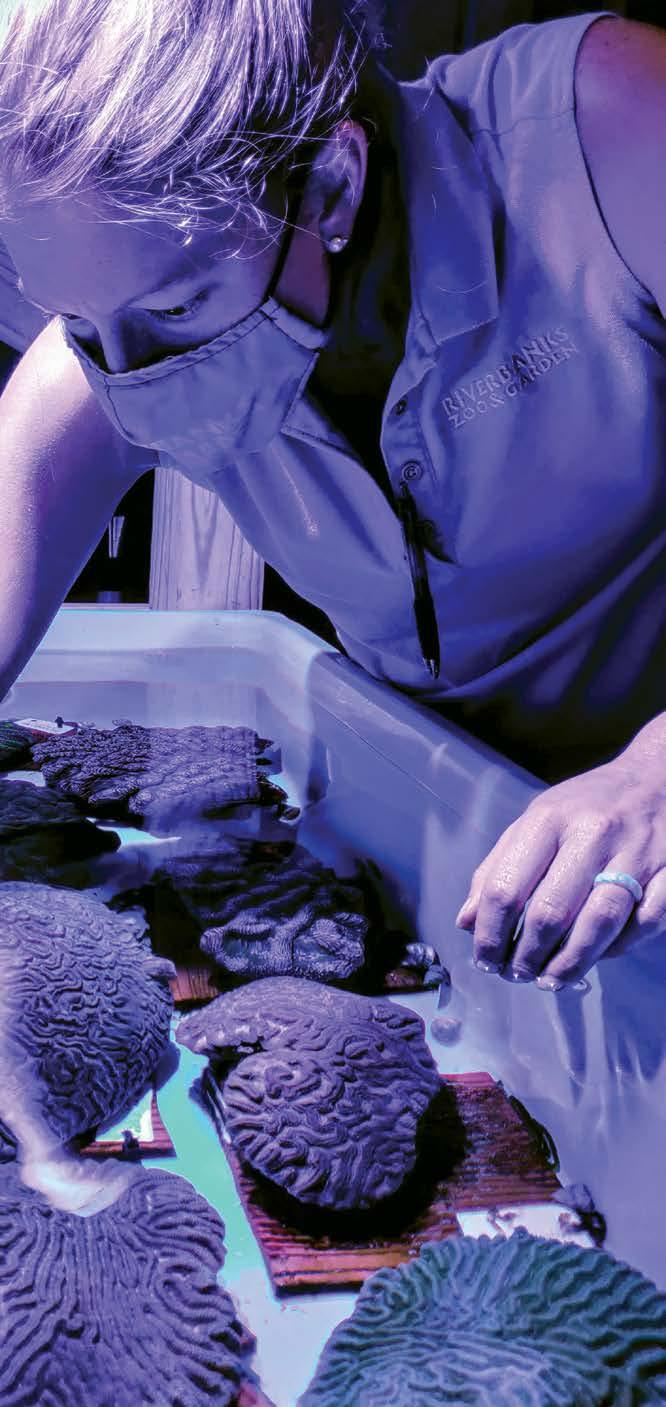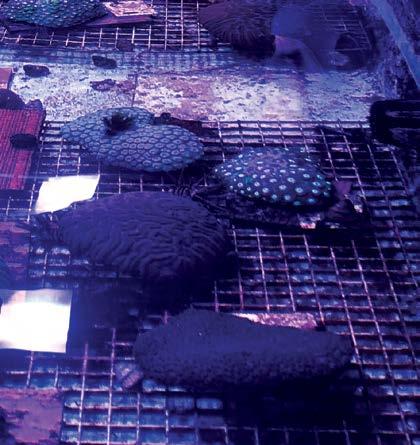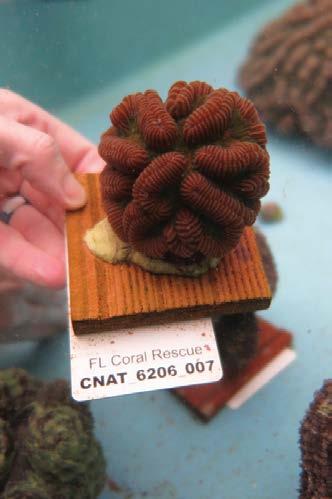
6 minute read
Reef to Refuge
Aquariums and zoos across the country, including Riverbanks Zoo and Gardens in South Carolina, took part in AZA’s coral reef restoration and rescue initiative.
JENNIFER RAWLINGS
AZA FLORIDA REEF TRACT RESCUE PROJECT (AZA-FRTRP)
List of AZA Facilities Engaged in Coral Rescue Efforts
Mote Marine Aquarium Sarasota, FL Mote.org
Blank Park Zoo Des Moines, IA BlankParkZoo.com
Butterfl y Pavilion Westminster, CO Butterfl ies.org
Columbus Zoo and Aquarium Columbus, OH ColumbusZoo.org
The Florida Aquarium Tampa, FL FLAquarium.org
Florida Coral Rescue Center Orlando, FL SeaWorld.org
Adventure Aquarium Camden, NJ AdventureAquarium.com Fort Worth Zoo Fort Worth, TX FortWorthZoo.org
Georgia Aquarium Atlanta, GA GeorgiaAquarium.org
Jenkinson's Aquarium Point Pleasant Beach, NJ Jenkinsons.com/ Aquarium
Maritime Aquarium Norwalk, CT MaritimeAquarium.org
National Aquarium Baltimore, MD Aqua.org
National Mississippi River Museum & Aquarium Dubuque, IA RiverMuseum.com
Omaha’s Henry Doorly Zoo Omaha, NE OmahaZoo.com Moody Gardens Galveston, TX MoodyGardens.com
Riverbanks Zoo & Garden Columbia, SC RiverBanks.org
SEA LIFE Michigan Aquarium Auburn Hills, MI VisitSeaLife.com/ Michigan
Texas State Aquarium Corpus Christi, TX TexasStateAquarium.org
Nashville Zoo, Inc Nashville, TN NashvilleZoo.org
Virginia Aquarium & Marine Science Center Virginia Beach, VA VirginiaAquarium.com
A RESCUE BRINGS HOPE
Late in 2019, scientists and conservation managers from NOAA Fisheries, Florida Fish and Wildlife Conservation Commission (FWC), the National Park Service, NOAA’s Offi ce of National Marine Sanctuaries and the Florida Department of Environmental Protection devised a daring rescue plan — bringing hope for the reef.
While scientists and fi eld researchers would work to determine the identity of the disease, how it spreads, and how to prevent or cure it, susceptible coral species would be removed ahead of the disease’s progression. Th ese corals would be placed in land-based nurseries for safe keeping. What was needed was expertise and space to hold the thousands of corals needed to secure the coral genetic biodiversity of the pre-disease reef communities.
“Aquariums and zoos had long been carrying out cutting edge conservation work with corals, and we knew that Association of Zoos and Aquariums-accredited facilities had the experience, knowledge, network, and the space to step forward and fi ll the need,” said Dan Ashe, president and chief executive offi cer of the Association of Zoos and Aquariums based in Silver Spring, Maryland. “Th e challenge was that most of the rescued coral species had never been held before, but we were confi dent that, with the professional aquarists we have on staff and remarkable facilities that are available, that we would be able to take a leading role in this rescue.”
In the fall of 2018, AZA was invited by the rescue planners to become custodians of corals from the reef. Corals quickly began arriving at AZA facilities across the country. By the end 2020, even as the world addressed the COVID-19 crisis, nearly 2,000 corals had been shipped by boat, plane, and truck for safe keeping at 18 AZAaccredited facilities in 12 states. Never before had such a large-scale rescue response to a coral crisis been mounted.
Federal, state and private partners collaborated to place corals in these areas: Connecticut and Michigan; coastal cities of Texas and New Jersey; the farmlands of Ohio, Iowa and Nebraska; the mountains of Colorado; and in the Southern metro areas of Georgia and South Carolina. In early 2020, NOAA Fisheries estimated that of the total $14.6 million invested in this coral rescue eff ort between 2018 and the end of 2020, more than $9 million had been contributed by AZA facilities. Never before had the AZA or its member facilities mounted such a rapid response to a marine crisis.

Left to right: Other facilities that helped rescue Florida’s coral included Columbus Zoo and Aquarium, Ohio; Adventure Aquarium, New Jersey; and an example of rescued coral, Colpophyllia natans, sits at The Florida Aquarium.
GOOD STEWARDSHIP
It takes time, dedication and perseverance to respond this quickly and eff ectively to save a national natural treasure.
Having a timely response to any health issue is the key to managing any animal long term. For rescue corals, it is fortunate that the holding facilities have a strong, dynamic and creative team of veterinarians, lab technicians, biologists and fi eld researchers. More than 100 of the nation’s best animal care professionals are working together to bring hope to Florida’s corals.
Th e rescue of corals from the Florida reef system will not fi x the reef. Finding the cause and cure of Stony Coral Tissue Loss Disease will not fi x the reef. Only public engagement that insists upon good stewardship of our natural resources will ultimately fi x the reef.
Th e rescued Florida corals and the AZA foster parents that care for them are looking to that future.






WHAT YOU CAN DO AT HOME TO HELP FLORIDA CORALS:
» Learn all you can about our ocean and the part reefs play in its health. Encourage others to do the same.
» No matter where you live, insist on responsible ecosystem management and reward appropriate management with your vote and your tax dollars.
» Visit or become a member of your local AZA-accredited zoo or aquarium. Responsible conservation starts at home, and many zoos and aquariums fund conservation efforts, like the Florida coral rescue, through gate admissions, memberships and the generosity of local donors.

Ocean Therapy
Healing waters soothe the soul no matter the trauma BY LOUISA SAX

WWhere do you go when you need time to reset, relax, de-stress, make decisions or get creative? I go to the ocean. A walk on the beach, snorkel or a day spent fishing works wonders for my ability to think lucidly. I am guessing that if you are reading this particular magazine, we might be similar.
The positive effects of “green space” on a person’s wellbeing has been widely researched with the evidence being utilized in town planning, real estate and alternative therapy among other industries. “Blue space” is now included in that discussion as the two are perceived to have commonalities. However, the effects of exposure to “blue space” has since become the topic of scientific inquiry, and BlueHealth, an organization funded by the European Union’s Horizon 2020 program, was established in 2016 to undertake much of the research. Many people have stories and experiences to share regarding their relationship with the ocean and how it makes them feel. Wallace J. Nichols, author of the fascinating book Blue Mind, reported that when qualitative data was collected on the topic, people were asked why they spend time near the water. The most common responses were “it makes me happy,” “it feels good” and “I’m not quite sure.”
Nichols explored the depths of psychological research to uncover why and how water is such a powerful motivator and healer. His supported hypothesis is that “being in, on, under or around water makes you happier, more connected and better at what you do”.
But what about more serious mental health conditions? If the ocean is such a powerful mood changer and creator of positive energy, can it also benefit those with diagnosed mental health issues, such as PTSD, depression, anxiety or addiction? The answer is yes, and there is now considerable scientific evidence to suggest that proximity to “blue space” can reduce the symptoms of “common mental health disorders.”
I read Blue Mind twice in preparation for this article, meticulously highlighting on almost every page. But anything that I write couldn’t possibly do the book justice, so my best advice would be to read it yourself. Seriously.
Instead, I will highlight some organizations that are seizing the power of this incredible healer to change the lives of those they help.










